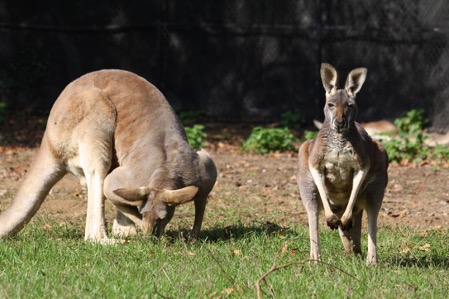Summary of This Just In: Kangaroos Like Working for Food, Don’t Mind an Audience:
The content discusses a scientific study conducted at the Detroit Zoo to determine the emotional well-being of kangaroos in the presence of guests. The study involved offering treats to the kangaroos and analyzing their behavior in response to the number of visitors in their habitat. The results showed that the kangaroos were not negatively affected by the presence of people, and the number of guests did not influence their willingness to work for treats. Additionally, the study found that the kangaroos enjoyed the challenge of obtaining treats from a foraging ball, which promotes mental stimulation and positive well-being in captive animals. The findings suggest that the kangaroos at the Detroit Zoo are comfortable with visitors and enjoy their presence.
Summary:
– This article discusses a study conducted at the Detroit Zoo to understand how the presence of visitors affects the well-being of kangaroos.
– The study involved offering kangaroos treats and observing their behavior in the presence of different numbers of visitors.
– The results showed that the kangaroos were not negatively affected by the presence of visitors and were willing to work for treats regardless of the number of people present.
– The study also revealed that the kangaroos enjoyed the challenge of obtaining treats from a foraging ball, indicating that working for food promotes their well-being.
—
Imagine visiting a zoo and getting the chance to walk through a habitat where kangaroos freely roam. It’s a unique experience that allows you to observe these magnificent marsupials up close. But have you ever wondered how the kangaroos feel about having people in their homes? As a graduate student in Hunter College’s Animal Behavior and Conservation program, I set out to answer this question in a fascinating investigation of kangaroo well-being.
Animal well-being encompasses an animal’s physical, mental, and emotional health. It varies from individual to individual and can be influenced by various factors. To understand how the Detroit Zoo’s kangaroos are affected by visitors’ presence, I collaborated with the Detroit Zoological Society (DZS) to conduct a scientific study.
The study’s main goal was to assess the emotional well-being of the kangaroos by observing their behavior when offered treats. We wanted to determine whether the number of visitors in the kangaroo habitat would impact their willingness to work for food. Like humans, animals are more likely to work harder for a reward when in a positive state of mind. Therefore, if the kangaroos experienced negative emotions in the presence of more people, we predicted they would be less inclined to work for treats.
We used a combination of location and a foraging ball challenge feeder to make the treats more challenging to access. We placed treats in the kangaroos’ favorite spot and another location they frequented less often. The treats were either directly on the ground or hidden within the foraging ball. We then analyzed the kangaroos’ interactions with the treats while considering the number of visitors present.
The study’s results were intriguing—the kangaroo’s preferred treats were placed in their favorite spot, rarely venturing to the less favored area. However, there were no observable effects of visitor presence on their behavior. This suggests that the number of people in their habitat did not negatively impact the kangaroos. It could be attributed to many of the kangaroos at the Detroit Zoo being born and raised there, making them accustomed to seeing people on the guest pathway.
But the study revealed an unexpected finding as well. When hidden inside the foraging ball, the kangaroos were far more likely to eat the treats. This phenomenon, known as contra-freeloading, is well-documented in captive animals. It shows that animals often prefer to work for their food, even if it’s readily available. Providing a challenge like a foraging ball could mimic some of the difficulties associated with foraging in the wild. This provided mental stimulation and promoted a sense of accomplishment for the kangaroos, contributing to their overall well-being.
These findings bring good news for the Detroit Zoo, the kangaroos, and all the visitors who love observing them. The study confirms that the kangaroos do not exhibit negative responses to the presence of people in their habitat, reinforcing the results of a previous study conducted at the zoo. Additionally, we may have unintentionally discovered a simple and enjoyable way to enhance the kangaroos’ lives by allowing them to work for their food.
In conclusion, the Detroit Zoo’s kangaroos have demonstrated that they are comfortable with visitors in their habitat and enjoy the challenge of obtaining treats through interactive means. This study sheds light on the complex nature of animal well-being and highlights the importance of designing enriching environments for captive animals. The Detroit Zoo’s Australian Outback Adventure truly offers a unique and fascinating experience for both the kangaroos and the visitors alike.


